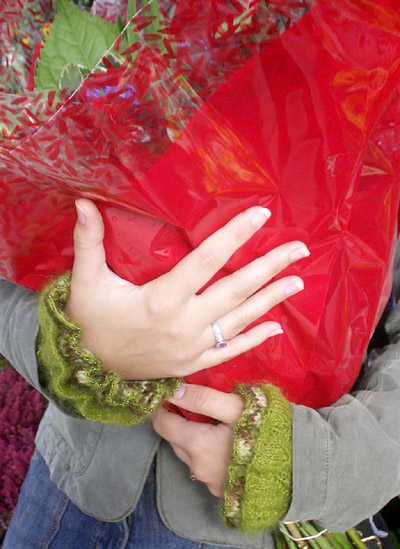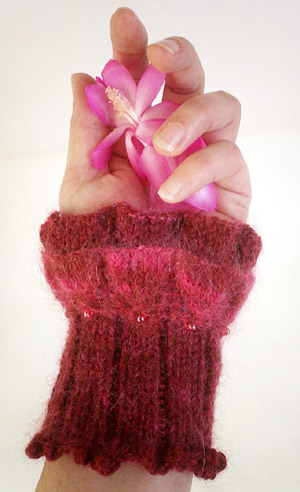
 Beaded
Cast On
Beaded
Cast On
Thread 54 size 11/0 Japanese seed beads onto
CC and push them about three yards along the
yarn, leaving enough free yarn for a long
tail CO.
Using larger needles and Long Tail method,
CO 108 sts as follows:
CO 1 st, PB, [CO 2 sts, PB] 53 times, CO 1
st. 108 sts.
Distribute sts evenly between needles and
join to begin working in the round, being
careful not to twist.
Set-Up Round: [P3, k9] to end.
Bottom Bell Edging
Using MC, work as follows:
Rounds 1 & 2: [P3, k9] around.
Round 3: [P3, ssk, k5, k2tog] around.
90 sts rem.
Round 4: [P3, k7] around.
Round 5: [P3, ssk, k3, k2tog] around.
72 sts rem.
Round 6: [P3, k5] around.
Round 7: [P3, ssk, k1, k2tog] around.
54 sts rem.
Round 8: [P3, k3] around.
Round 9: [P3, sl 1, k2tog, psso]
around. 36 sts rem.
Rounds 10 & 11: [P3, k1] around.
Do not break yarn. Set aside and work Top
Bell Edging.
Top Bell Edging
Thread 9 size 8/0 Czech glass beads onto CC,
and push them along the yarn. You will not
need them for a little while, so push them
a long way up the yarn.
Using smaller needles and Long Tail method,
CO 108 sts.
Distribute sts evenly between needles and
join to begin working in the round, being
careful not to twist.
Continuing with CC, work Rounds 1-9 as for
Bottom Bell Edging, then proceed as follows:
Round 10: [P3, PBK] to end.
Round 11: P all sts; each time you
work a st that was beaded on the previous
row, pull the bead up the stitch to sit on
the bump formed by the new purl stitch.
Do not break yarn.

 Join
Bell Edgings
Join
Bell Edgings
The technique known as the three-needle bind
off is normally used to join two edges that
have the same number of stitches. The technique
used to join the Bell Edgings is similar;
it differs only in that you will not actually
be binding off stitches, just knitting two
stitches together off two different needles.
Begin by centering the stitches of the Top
Bell Edging along the needles, and spreading
them out to create as large an opening through
the needles as possible. Do the reverse to
the stitches of the Bottom Bell Edging --
center them on the needles, and squish them
together, as far as they will go. You will
be passing the Bottom Bell Edging through
the needles of the Top Bell Edging, so you
want to compact the Bottom Bell Edging and
make it as small as possible.
Next, making sure that the working yarn,
and the beginnings of the rounds of both bell
edgings are lined up, pass the Bottom Bell
Edging down through the opening between the
needles of the Top Bell Edging. Line up each
needle of the Bottom Bell Edging with its
corresponding needle from the Top Bell Edging.
When they are properly aligned, each larger
needle from the Bottom Bell Edging will sit
directly behind a smaller needle from the
Top Bell Edging. Align the first stitch of
the round of each edging, so that the working
yarn from each edging can be held together,
ready to knit the first stitch.
To begin joining round, hold first needle
of Bottom Edging together with first needle
of Top Edging in left hand, and work with
a needle in the larger size (size used for
Bottom Edging). Work with strand of MC from
Bottom Edging and strand of CC from Top Edging,
held together.
Joining Round: [Insert working
needle into first st on each needle, from
front to back, as if to knit; k these sts
together] until all sts have been worked.
36 sts on larger needles.
Wrist Ribbing
Using MC and CC held together, work as follows:
Next Round: K1, [p1, k3] to last
3 sts, p1, k3.
Repeat this round 19 times more. Break off
CC.
Picot Bind Off
Using MC only, BO 1 st, [turn work and CO
2 sts using Cable Cast On, turn work and pass
second st over first st, pass third st over
second st (one st rem on right needle); BO
2 sts] to end.

